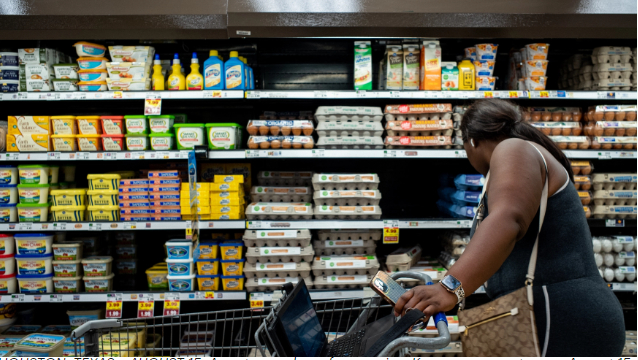June 21, 2025 | 03:37 GMT +7
June 21, 2025 | 03:37 GMT +7
Hotline: 0913.378.918
June 21, 2025 | 03:37 GMT +7
Hotline: 0913.378.918

A customer shops for eggs in a Kroger grocery store on August 15, 2022 in Houston, Texas. Egg prices steadily climb in the U.S. as inflation continues impacting grocery stores nationwide. Photo: Brandon Bell/Getty Images
there are a few grocery items that could be putting extra pressure on your wallet.
The latest data from the Labor Department, released Wednesday, show inflation is still a growing problem in the U.S. with consumer prices rising 8.3% over the last year and 0.1% from July.
Apart from declining prices at the gas pumps, consumer prices for everything from food and rent to furniture, medical care and new cars got pricier last month. Some of the highest price increases since last year are being felt at the grocery store, according to the Labor Department’s data.
Among the hardest-hit grocery items are eggs. The price of eggs is up nearly 40% compared to a year ago, jumping almost 3% between July and August alone. This has been a trend since spring when eggs exceeded $3 for the second time in history, sparked by a bird flu outbreak, supply chain issues, and high feed costs.
Below are the five items that have seen the largest year-over-year price increase based on the latest report from the Labor Department, and how much the price has changed:
Eggs 39.8%
Margarine: 38.3%
Butter: 24.6%
Flour/prepared flour mixes: 23.3%
Olives, pickles, relish: 19.4%
Many of the items listed in the Consumer Price Index have seen prices rise by more than 15% compared to August 2021. That includes chicken (16.6%), soups (18.5%), cereals (17.4%), and milk (17%).
Margarine and olives, pickles, and relish were among the grocery items seeing the largest price increases between July and August of this year. The price of frankfurters is up more than 5%, the highest month-to-month increase among meat products. Potatoes and canned fruit each saw prices rise by about 3%.
Not every food has seen price hikes in recent weeks. Prices for some fresh produce – apples, bananas, and citrus fruits – and uncooked beef steaks are down since July.
Severe weather – everything from heat and droughts to overwhelming rain – could pinch the U.S.’s food supply in the coming weeks, CNN reports. The cost of food production and the Russia-Ukraine war are also feeding the rising costs, according to Quartz.
Worsening food inflation is a particular strain on lower-income families, more of whom have had to turn to food banks and other aid as inflation has worsened. Mary Jane Crouch, executive director of America’s Second Harvest of Coastal Georgia, which works with a network of food banks, told the Associated Press 38% more food was distributed in August compared with July.
Sales at grocery stores rose 0.5% in August, the Commerce Department reported Thursday. Overall spending has slowed and shifted increasingly toward necessities like food, while spending on electronics, furniture, new clothes and other non-necessities has faded.
(The Hill)

(VAN) Poultry production in Poland, which has only started recovering from devastating bird flu outbreaks earlier this year, has been hit by a series of outbreaks of Newcastle disease, with the veterinary situation deteriorating rapidly.

(VAN) Extensive licensing requirements raise concerns about intellectual property theft.

(VAN) As of Friday, a salmonella outbreak linked to a California egg producer had sickened at least 79 people. Of the infected people, 21 hospitalizations were reported, U.S. health officials said.

(VAN) With the war ongoing, many Ukrainian farmers and rural farming families face limited access to their land due to mines and lack the financial resources to purchase needed agricultural inputs.

(VAN) Vikas Rambal has quietly built a $5 billion business empire in manufacturing, property and solar, and catapulted onto the Rich List.

(VAN) Available cropland now at less than five percent, according to latest geospatial assessment from FAO and UNOSAT.

(VAN) Alt Carbon has raised $12 million in a seed round as it plans to scale its carbon dioxide removal work in the South Asian nation.